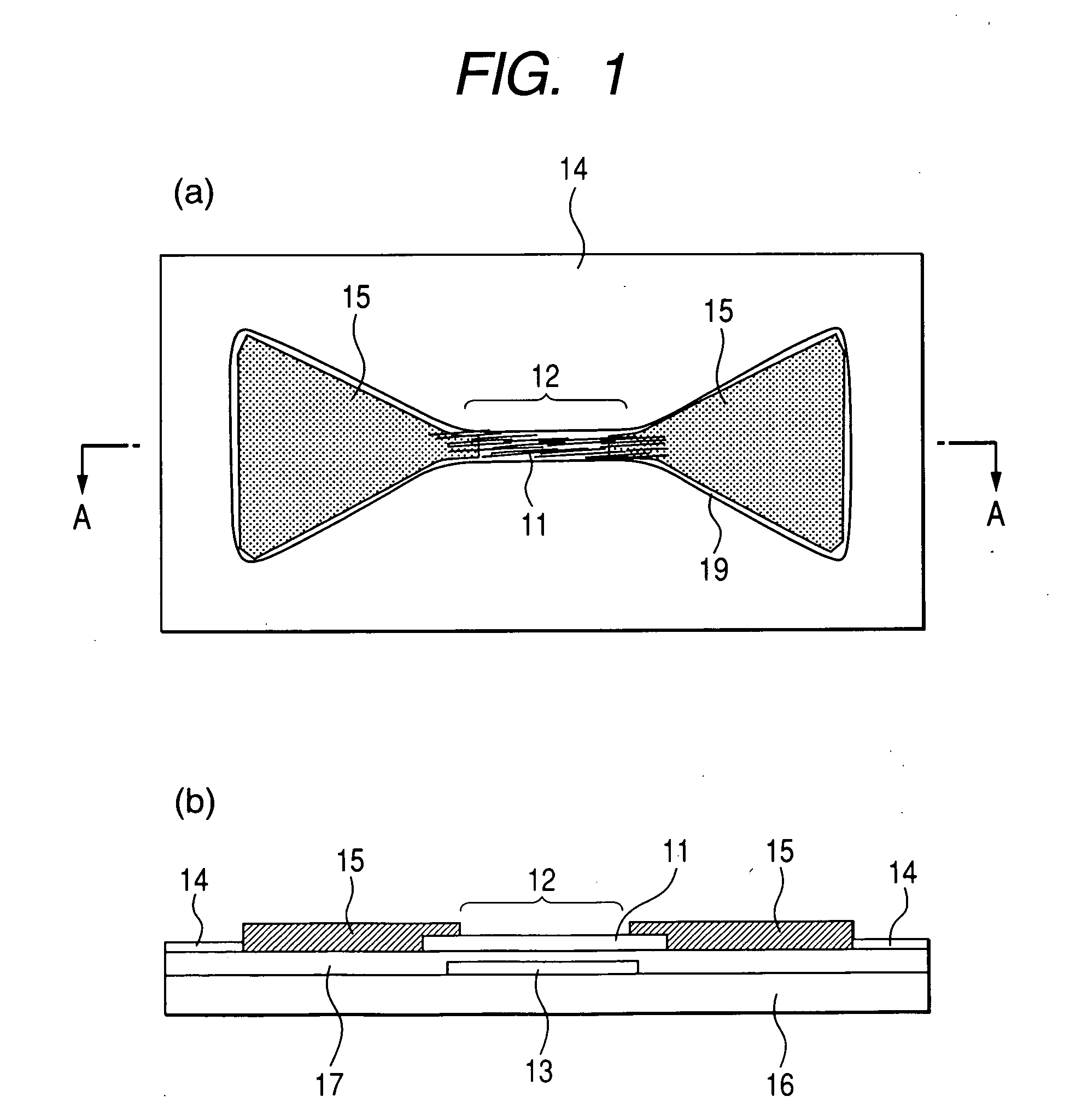Field effect transistor and its manufacturing method
a field effect transistor and manufacturing method technology, applied in the direction of basic electric elements, electrical appliances, semiconductor devices, etc., can solve the problems of compatibility of cost and productivity requested, slow performance of fet, and disadvantage in cost and productivity
- Summary
- Abstract
- Description
- Claims
- Application Information
AI Technical Summary
Benefits of technology
Problems solved by technology
Method used
Image
Examples
first embodiment
[0047]FIGS. 5A to 5E show a concrete example in which TFT according to the invention is formed using inorganic materials. In FIGS. 5A to 5E, sectional views are shown on the left and plans are shown on the right.
[0048] As shown in FIG. 5A, to form a gate electrode 13 on a silicon substrate 16, an aluminum thin film having the thickness of 30 nm is formed on a thermal oxide film 17 by sputtering evaporation. The gate electrode 13 is formed by forming the aluminum film in a pattern shown in the plan by photolithography. That is, in a first embodiment, TFT including the aggregate of narrow plural channels in the channel region shown in FIG. 3 is formed. In the first embodiment, the length of the gate electrode is set to 1 mm, the width of the narrow channel is set to 50 μm, and channel width is set to 5 mm as a whole.
[0049] Next, as shown in FIG. 5B, a silicon oxide insulator 51 having the thickness of 20 nm is formed by spurring evaporation. Further, resist is coated by a spin coat ...
second embodiment
[0059] In a second embodiment, a method of producing TFT which uses flexible materials for a substrate and an insulator and which does not use lithography in a low-priced way such as printing and application will be described.
[0060] As in the method of forming the source and drain electrodes in the first embodiment, a gate electrode 13 having the pattern shown in FIG. 1A is printed on a plastic substrate using conducting ink. This is baked and the metal electrode 13 is formed; however, as plastic is used for the substrate, attention is required to be paid to softening temperature. In the second embodiment, a highly transparent polyimide sheet having the thickness of 100 μm is used for the substrate and as the baking temperature is set to approximately 300° C., it is verified that the substrate sufficiently endures the baking temperature of 120° C. in case water-based solution of silver nanoparticles is used. To form a gate insulator, polymethylmethacrylate (PMMA) is applied by a sp...
third embodiment
[0063] In a third embodiment, an example in which a pixel of an active matrix display device using TFT according to the invention for a driver circuit is manufactured will be described.
[0064]FIG. 6A shows an equivalent circuit for 3×3 pixels of the active matrix display device which uses TFTs of this invention in the driver circuit. A circuit for driving a pixel of a liquid crystal display cannot be used for a driver circuit for an organic electroluminescence device as it is as described on pp. 163 to 167 of the April 24 issue in 2000 of the Nikkei Electronics and one extra TFT is required for current control, compared with a liquid crystal. In this embodiment, a method of manufacturing a driver circuit which uses two TFTs per pixel will be described as described on pp. 163 to 167 of the April 24 issue in 2000 of the Nikkei Electronics and in JP-A No. 316295 / 2003.
[0065] A reference number 618 denotes a driver circuit for scan lines and the driver circuit sends a signal to the scan...
PUM
 Login to View More
Login to View More Abstract
Description
Claims
Application Information
 Login to View More
Login to View More - R&D
- Intellectual Property
- Life Sciences
- Materials
- Tech Scout
- Unparalleled Data Quality
- Higher Quality Content
- 60% Fewer Hallucinations
Browse by: Latest US Patents, China's latest patents, Technical Efficacy Thesaurus, Application Domain, Technology Topic, Popular Technical Reports.
© 2025 PatSnap. All rights reserved.Legal|Privacy policy|Modern Slavery Act Transparency Statement|Sitemap|About US| Contact US: help@patsnap.com



